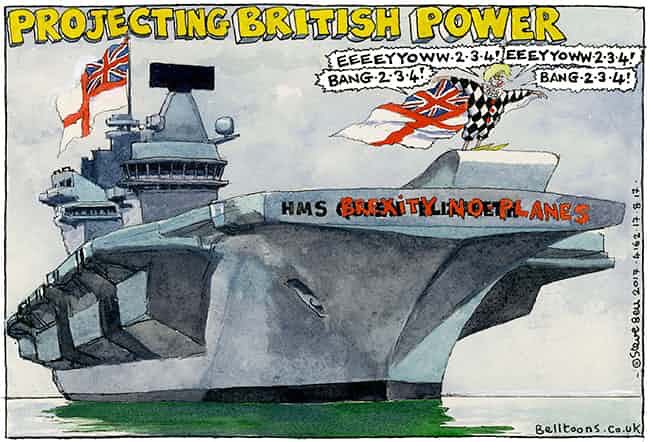General characteristics
Type: Aircraft carrier
Displacement: 70,600 tonnes (69,500 long tons; 77,800 short tons)[5][6]
Length: 280 m (920 ft)[7]
Beam:
39 m (128 ft) waterline
73 m (240 ft) overall[8][9]
Draught: 11 m (36 ft)
Decks: 16,000 m2 (170,000 sq ft) 9 decks beneath flightdeck with hangar covering the centrepiece of two decks (without islands)
Installed power:
2 × Rolls-Royce Marine Trent MT30 36 MW (48,000 hp) gas turbine engine
4 × Wärtsilä 38 marine diesel engines (2 × 12V38 8.7 MW or 11,700 hp & 2 × 16V38 11.6 MW or 15,600 hp)
Propulsion:
Full integrated electric propulsion
4 × Converteam 20 MW (27,000 hp)) Advanced Induction Motors
2 × shafts; fixed pitch propellers
Speed: In excess of 25 knots (46 km/h; 29 mph)
Range: 10,000 nautical miles (19,000 km; 12,000 mi)
Troops: 250[10] to 900[11]
Complement: 679 crew, not including air element; total berths for up to 1,600
Sensors and
processing systems:
S1850M long range radar
Type 997 Artisan 3D medium range radar
Ultra Electronics Series 2500 Electro Optical System (EOS)
Glide Path Camera (GPC)
Armament:
At least 3 × Phalanx CIWS[12]
30-mm DS30M Mk2 guns
Miniguns
Aircraft carried:
Carrier Air Wing of up to 40 aircraft (50 full load):[13]
F-35B Lightning II
Chinook
Apache AH64
Merlin HM2 and HC4
Wildcat AH1 and HMA2
Merlin Crowsnest AEW
Aviation facilities:
Large flight deck with ski jump
Hangar deck
Two aircraft lifts
Notes: Capable of carrying more than 70 aircraft[14]

